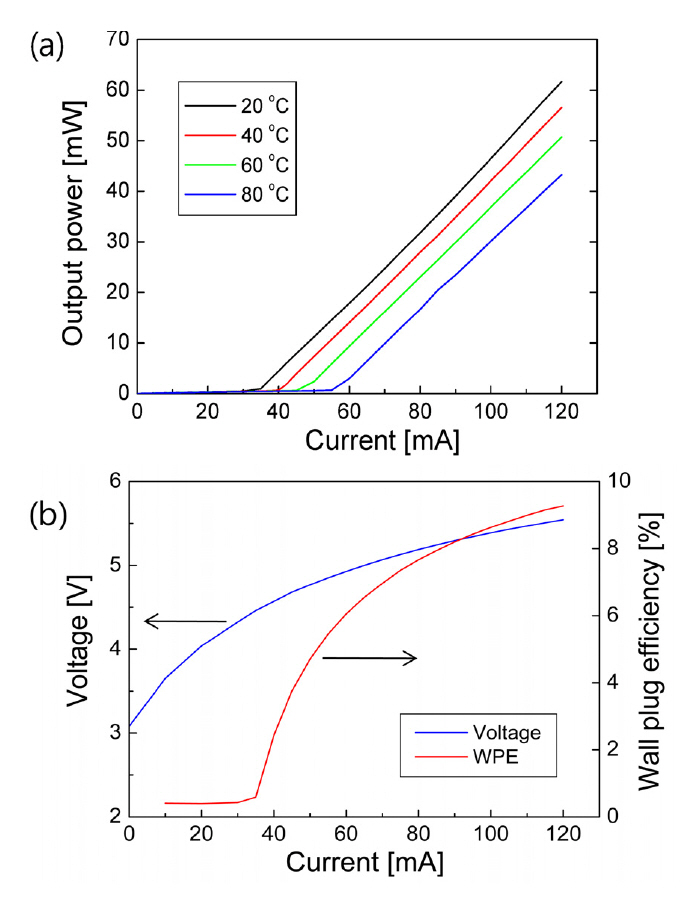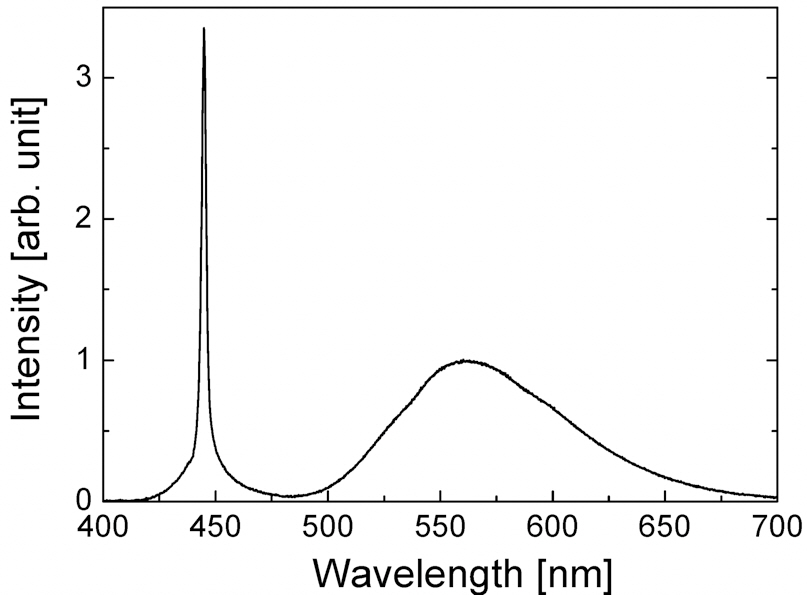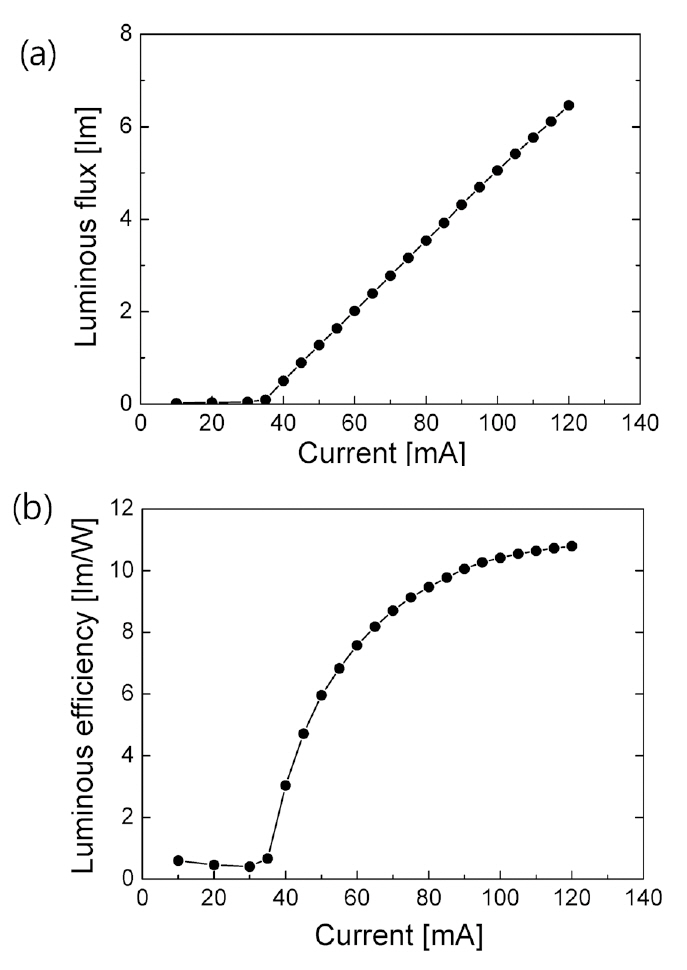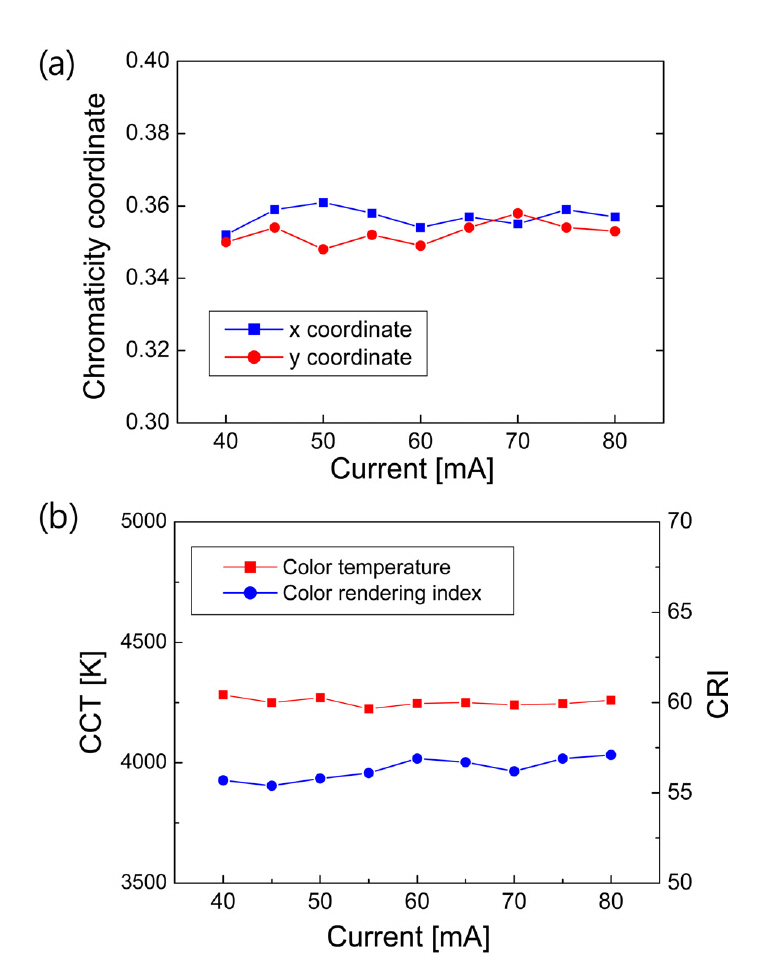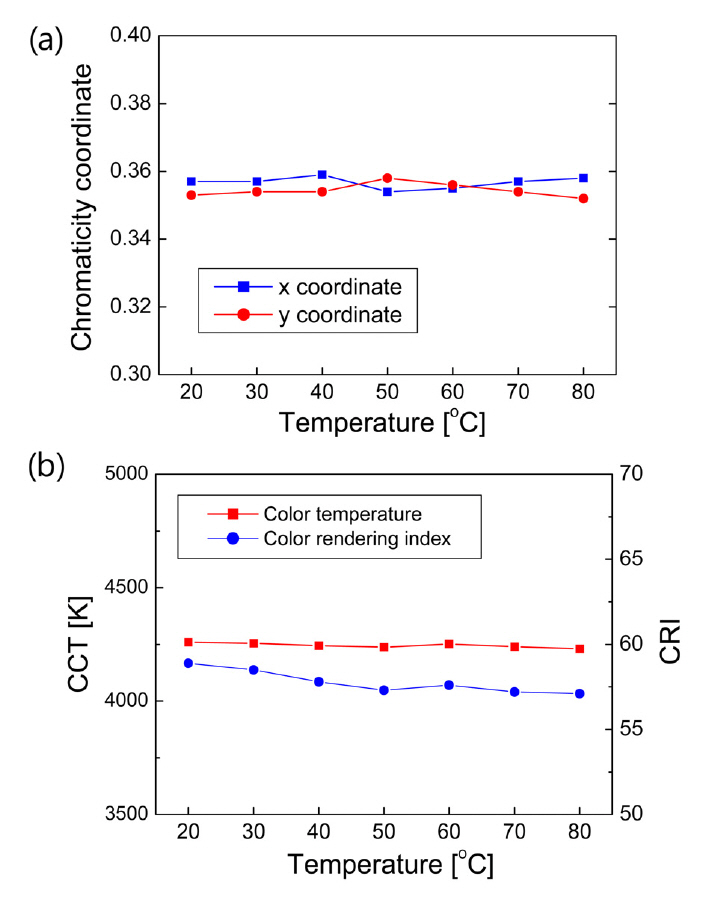



A phosphor-conversion white light source is demonstrated using an InGaN-based blue laser diode (LD)and a yellow-emitting phosphor excited by the blue LD. The photometric and colorimetric properties of this blue-LD-based white light source are characterized. When injection current of the LD is 100 mA,luminous flux and luminous efficiency of the white light are found to be over 5 lm and 10 lm/W,respectively. When injection current is >90 mA, luminance is estimated to be larger than 10 Mcd/cm2.In addition, color characteristics of the white light such as chromaticity coordinates, a correlated color temperature, and a color rendering index are found to be quite stable as current and temperature of the LD varies. The demonstrated LD-based white light source is expected to be used in high-brightness illumination applications with good color stability.
GaN-based light-emitting diodes (LEDs) have found various applications such as traffic signals, automobile lamps, back lights in liquid-crystal displays, and illumination systems[1,2]. In particular, solid-state lighting based on the GaN LEDs has attracted great interest as a high-energy-efficiency and environment-friendly lighting technology. The applications of GaN-based white LEDs toward general lighting require high-power and high-efficiency operation. Recently developed LEDs have demonstrated high-power of >1 W and high-efficiency of >100 lm/W [3, 4]. In some illumination applications, small-size and high-brightness light sources are required. Due to the small source size, LEDs are well suited for such applications [3-5]. In photometry,source brightness corresponds to the luminance of devices which is defined as the ratio of luminous flux to the source etendue [2]. Therefore, it is important to manufacture white light sources with small light-emitting area and low beam divergence as well as high output power for realizing high brightness sources.
One interesting example of the high-brightness white light sources is a phosphor-conversion white light based on an InGaN laser diode (LD) and phosphors excited by the LD, which was first demonstrated by Nichia [6]. Due to the small emission spot size, this LD-based white light source was named ‘Micro White’ and high luminance is expected at relatively low operation power. Two types of LD-based white light sources have been introduced. One is based on a 405-nm violet LD and blue/yellow phosphors[6, 7], and another is using a 450-nm blue LD and a yellow phosphor [8]. The mechanism of white light emission in these LD-based white sources is basically similar to that of phosphor-conversion white LEDs. In the violet-LD-based white light, a 405-nm LD excites both blue and yellow phosphors to emit blue and yellow light that is mixed to produce white light. In the blue-LD-based white light, part of the 450-nm blue laser light is absorbed in the yellow phosphor and the unabsorbed blue laser light is transmitted outside the phosphor. The yellow light emitted from the phosphor is mixed with transmitted blue laser light to appear as white light.
In principle, the blue-LD-based white light shows higher efficiency than the violet-LD-based one because the Stoke’s shift loss during wavelength conversion in the phosphor is lower. Stoke’s shift loss at the phosphor increases as the wavelength difference between excitation light of a pump source and emission light from the phosphor increases. In FIG. 1. (a) Light-current (L-I) curves of the blue laser diode(LD) for temperatures from 20 to 80℃. (b) Voltage and wall plug efficiency (WPE) of the LD as a function of current when temperature is 20℃.addition, the transmitted blue laser light can be used for high-speed data communication by modulating the LD.Although the blue LD-based white light source was first introduced by Nichia several years ago [8], the characteristics of this white light has not been presented in detail compared to those of violet-LD-based white light [6, 7]. In this paper, we experimentally demonstrate the blue-LD based white light, and investigate its photometric and colorimetric properties such as luminous flux, chromaticity coordinates, correlated color temperature (CCT), and a color rendering index (CRI).
An LD-based phosphor-conversion white light source was assembled using an InGaN blue LD and an Eu-doped silicate [(BaSr)2SiO4:Eu2+] yellow phosphor. The structure and characteristics of the blue LD are similar to those reported in Refs. [9-11]. The multiple-quantum-well (MQW)active layers of the LD are composed of two pairs of a 25A-thick In0.16Ga0.84N wells that were designed to emit blue light around 445 nm. The configuration of the white light system is basically similar to that shown in Ref. [8]. The blue laser light was coupled into one end of a plastic optical fiber with core diameter of 400 ㎛. The other end of the optical fiber was covered with some amount of the yellow phosphor. When the phosphor was excited by the blue LD, yellow light generated at the phosphor was combined with blue laser light to emit white light.
The output characteristics of the LD were measured under continuous-wave operation with varying temperatures of the LD. The operation temperature of the LD was adjusted by a thermo-electrically controlled module. Peak emission wavelength exists around 445 nm above threshold at 20℃. Fig. 1(a) shows output power versus current (
The characteristics of the assembled white light were measured by using a spectro-radiometric system by Ocean Optics, Inc [12]. The white light emitted from the optical fiber was collected by an integrating sphere and coupled into a spectrometer for photometric and colorimetric measurements.Spectral data were analyzed based on the standard by Commission International de I’Eclairage (CIE) to evaluate
luminous flux, illuminance, chromaticity coordinates, a CCT,and a CRI. We measured the color data with changing operation current and temperature of the LD to investigate the stability of the white light.
Fig. 2 shows a spectrum of the white light source measured at 20℃ when injection current is 40 mA. The sharp peak around 445 nm corresponds to laser light transmitted through the phosphor, and a broad spectral region from 500 nm to 700 nm originates from the phosphor excited by the LD. The peak wavelength and full-width at halfmaximum of the spectrum by the phosphor is 563 nm and 87 nm, respectively, corresponding to yellow-green color.Proper combination of the blue and the yellow light gives white light as in usual white LEDs [2]. Since spectral linewidth of the blue light is much narrower than that of the yellow light, peak intensity of the blue laser light should be higher by more than 3 times to exhibit white light.
A typical
curve of the white light shows good linearity as in the
Luminous efficiency of the white light is shown in Fig.3(b) as a function of injection current of the LD. It increases sublinearly with current and becomes >10 lm/W when the injection current is >90 mW. The efficiency curve of the white light is basically similar to that of the WPE of the LD shown in Fig. 1(b). Note that the luminous efficiency does not decrease even at high injection current of >100 mA. This is in strong contrast to the case of usual white LEDs where efficiency begins to decrease substantially as injection current increases. This ‘efficiency droop’phenomenon has limited high-power and high-efficiency operation of LEDs, and there have been controversial issues on the mechanisms and remedies for the efficiency droop [4, 13-16]. On the contrary, the LD-based white light does not undergo the efficiency droop problem. This basically results from the fact that the LD does not exhibit the efficiency droop due to the good linearity of the
However, the luminous efficiency of the demonstrated white light source is too low compared to >100 lm/W luminous efficiency of up-to-date high-efficiency white LEDs. There are several reasons for this low efficiency.First, power-conversion efficiency of the LD is quite low.The WPE of the LD at 100 mA was only 8.5%. Second,there is energy loss during wavelength conversion at phosphor from blue to yellow light. This Stoke’s shift loss is estimated to be ~20%. Considering that the maximum theoretical efficiency of white light is ~300 lm/W, these two effects reduce the luminous efficiency to ~20 lm/W.Third, the remaining loss was caused during optical coupling from the LD to the fiber and the fiber to the spectro-radiometer. By comparing the measured luminous efficiency and the two loss-causing effects mentioned above, the coupling losses are estimated to be ~50%.Therefore, the luminous efficiency can be increased by improving the performance of the blue LD and the coupling efficiency of white light. Recently reported WPE of high-power blue LDs can be as high as 24% at 1000-mW output power [17]. By using such high-power and high-performance blue LDs, luminous efficiency of the LD-based white light source will increase substantially.
Luminance of the white light source can be estimated from the measured luminous flux by using the relations between photometric quantities [18]. First, luminous exitance of the white light is determined by dividing the luminous flux by source area. Assuming that the area of the white light source is the same as the area of the fiber,the luminous exitance on the 400-㎛-diameter fiber is obtained to be ~4×107 lm/m2 when luminous flux is 5 lm.Second, luminance of the white light can be determined from the luminous exitance. For a perfect Lambertian surface, luminous exitance is equal to π times luminance.Consequently, luminance is estimated to be 12.7 Mcd/m2 for the luminous exitance of 4×107 lm/m2. The luminance of our white light source becomes >10 Mcd/m2 when luminous flux is higher than 4 lm or injection current is larger than 90 mA. High-brightness white light with luminance of >10 Mcd/m2 has also been demonstrated from several light sources such as high-power LEDs,halogen filament lamps, and high-intensity discharge (HID)arc lamps [2]. However, these high-luminance light sources operate at high luminous flux of >100 lm, which requires high input electrical power. In our LD-based white light source, in contrast, high luminance can be achieved with relatively low input power. This property can be used in some specific applications that require low-power, small-size,and high luminance light sources.
Next, color characteristics of the white light source are investigated. Fig. 4 and 5 show color data such as chromaticity coordinates, a CCT, and a CRI as a function of injection current and temperature of the LD, respectively.Here, chromaticity coordinates in the CIE xy chromaticity diagram are plotted. In Fig. 4, current was increased from 40 mA to 80 mA at fixed temperature of 20℃. In Fig. 5,operation temperature of the LD was increased from 20 to 80℃ when LD output power was 20 mW. The range of chromaticity coordinates are 0.35~0.36 and that of CCT are 4200~4300 K, which well represent the properties of white light. CRI is foundto be less than 60, somewhat lower than the CRI of conventional white light sources such as white LEDs and fluorescent lamps. The low CRI results from the narrow spectrum in the blue wavelength region corresponding to the sharp laser light spectrum.
As one can see from Fig. 4 and 5, the chromaticity coordinates,CCT, and CRI are stable to the change of current and temperature of the LD. The ratio of the standard deviation to the average value of color parameters is 0.2 ~1.2 % as current and temperature varies. Fluctuations of the color parameters with current or temperature are attributed to the variation of phosphor conversion efficiency,the instability of LD output, or environmental noise. The stable color characteristics imply that the spectral shape of the white light does not change much with current and temperature, which is due to the spatial separation of the white light emission region and the LD where most of heat is generated. In usual white LEDs, especially for multichip LEDs, color characteristics can be changed significantly with temperature [1], which may cause problems in some illumination applications. On the contrary, the LD-based white light does not have such a temperaturerelated problem. Therefore, it is expected that the demonstrated white light source will find some important applications where stable color characteristics are required.
We demonstrated a phosphor-conversion white light source based on an InGaN-based blue LD emitting at 445 nm and a yellow phosphor. By combining the blue laser light and yellow light from the phosphor excited by the blue LD, high-brightness white light was realized. When the injection current of the LD was 100 mA, the luminous flux and the luminous efficiency of the white light source were found to be over 5 lm and 10 lm/W, respectively.The luminous efficiency of the LD-based white light source increased sublinearly with current. The luminance of the white light source was estimated to be >10 Mcd/cm2,suitable for the high-brightness illumination application. In addition, color characteristics such as chromaticity coordinates,correlate color temperature, and color rendering index were found to be quite stable to the change of injection current or temperature of the LD.
